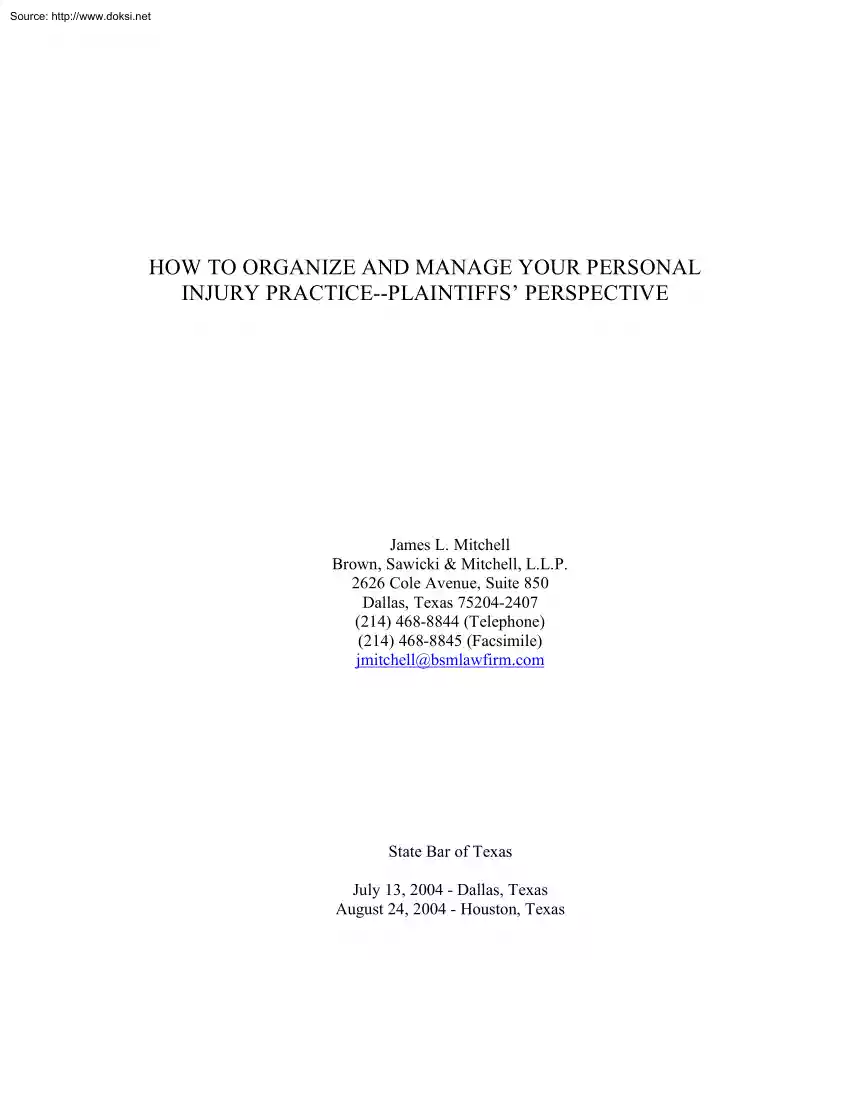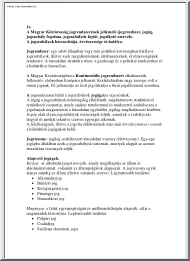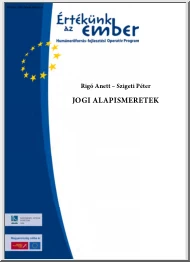Datasheet
Year, pagecount:2009, 7 page(s)
Language:English
Downloads:2
Uploaded:June 10, 2019
Size:521 KB
Institution:
-
Comments:
Attachment:-
Download in PDF:Please log in!
Comments
No comments yet. You can be the first!Most popular documents in this category
Content extract
Source: http://www.doksinet HOW TO ORGANIZE AND MANAGE YOUR PERSONAL INJURY PRACTICE--PLAINTIFFS’ PERSPECTIVE James L. Mitchell Brown, Sawicki & Mitchell, L.LP 2626 Cole Avenue, Suite 850 Dallas, Texas 75204-2407 (214) 468-8844 (Telephone) (214) 468-8845 (Facsimile) jmitchell@bsmlawfirm.com State Bar of Texas July 13, 2004 - Dallas, Texas August 24, 2004 - Houston, Texas Source: http://www.doksinet HOW TO ORGANIZE AND MANAGE YOUR PERSONAL INJURY PRACTICE – PLAINTIFFS’ PERSPECTIVE I. CLIENT DEVELOPMENT Developing clients for a personal injury practice depends upon the type of practice you wish to develop. If you are attempting to develop a small volume specialty practice, this will likely be based on referring attorneys and is a longer term approach than a high volume practice not based on referring lawyers. The following is a list of activities to consider when attempting to develop a referral-based personal injury practice: 1. Firm brochures; 2. Letters and mail
outs; 3. Electronic newsletters; 4. Bar activities; 5. CLE and speeches; and 6. Social interaction. On the other hand, developing a high volume practice will require more upfront money but can often provide more immediate results. The following are some activities useful in developing non-lawyer referrals: 1. Advertising – Yellow Pages, newspaper print, and television advertising; 2. Sponsor Groups – consider working with consumer advocacy groups like MADD and Elder abuse societies; 3. Website; and 4. Consider using a media/PR firm. 1 Source: http://www.doksinet II. PRODUCING THE WORK A. Staffing. The most important aspect in producing and managing the work in a PI practice is the selection of not only the proper staff but the proper mix of staff. In setting up a personal injury practice, you should consider the following types of staff: 1. Legal assistant/paralegal; 2. Typist/word processor; 3. Investigators; 4. Nurse consultants; 5. Office manager;
6. Overflow/contract/research attorneys; and 7. Medical record custodian. B. Organization. Disorganization is often a major stumbling block for most plaintiff personal injury firms. The proper organization should include master case plan meetings and regular case meetings resulting in action item lists. A successful personal injury practice must involve a proactive approach of working the cases up to resolution. Case meetings and action item plans should include investigation through discovery and trial. C. Standardized Practices A successful personal injury practice should include a certain amount of standardized forms and practices in order to facilitate organization. Standardized forms and practices help facilitate efficient work, particularly by the staff. 2 Source: http://www.doksinet D. 30-60-90 Day List. A regular list of cases to be resolved at 30, 60, 90 day time periods helps focus the entire office. E. Joint Ventures. You may consider joint venturing cases
and projects with other lawyers or law firms to help spread the risks and create a more efficient workload for your office. F. Calendaring and Case Lists. A successful personal injury practice should include an effective calendaring and case list system. An efficient calendaring system can greatly enhance an effective personal injury practice and prevent legal malpractice. Additionally, maintaining a proper case list with routine information on it, such as trial settings, statute of limitations, and other deadlines can also facilitate an effective personal injury practice. G. Filing System. An appropriate filing system is essential. H. III. Phone System/Voice Mail. FINANCIAL MANAGEMENT A. Overhead. A successful personal injury practice should include a detailed and thorough analysis and allocation of overhead, including rent, employee salary expenses, as well as other fixed costs. A fine line must be walked between too much overhead and not enough resources to accomplish
your goals. 3 Source: http://www.doksinet B. C. Lines of Credit. 1. Bank. 2. Brokerage Accounts. 3. Personal Cash. 4. Alternative Financing Arrangements. Bookkeeper/Accountant. The proper financial management of a personal injury law firm requires an accurate and efficient use of bookkeepers and accountants. D. Case Costs. One thing unique to the personal injury practice is the enormous expenses that the Plaintiff’s lawyer must carry until resolution of the case. This requires fronting large amounts of capital to work cases, especially high-end cases, such as product liability or medical malpractice cases. Case budgets, expense reports, and time tables should be used in order to properly budget case costs to adequately cash flow a personal injury firm. E. Case Selection. Poor case selection can quickly derail a plaintiff’s firm. F. Employee Bonuses. A proper bonus program can effectively motivate staff. G. H. Employee Benefits. 1. Health insurance; 2.
401K; and 3. Disability insurance. Copy Machine. 4 Source: http://www.doksinet I. Associate Attorneys’ Authority. Careful controls should be placed on associate attorneys regarding their ability to spend funds on behalf of a personal injury firm. Lawyers who do not have an ownership interest in the firms often do not have a full appreciation of the importance of keeping case expenses under control. J. Referral Fees. Appropriate referral fee arrangements are critical to a profitable personal injury practice. Large referral fees can result in unprofitable cases K. Solo Firm or Partnership. Office sharing arrangements and partnerships can effectively reduce overhead due to the economies of scale. L. IV. IOTA Account. TECHNOLOGY A. Computer System. B. Phone System. C. Internet Research/Websites. Internet research can provide useful information in pursuing a personal injury case. 5 Source: http://www.doksinet D. Databases. Databases can be used to efficiently
manage data in large personal injury cases. E. Industry Groups-AEIG, et cetera . You should join the appropriate industry groups to utilize the available information on behalf of your clients. F. List Serves. Personal injury practice groups have very effective list serves allowing you to share and obtain information from other attorneys working on similar cases. G. Case Management Software. Case management software exists to help provide information and utilize forms in higher volume practices. H. Demonstrative Evidence. The use of demonstrative evidence should be considered in the presentation of every case. The use of either Powerpoint or DVD for presentations can greatly enhance the value of a case. 6
outs; 3. Electronic newsletters; 4. Bar activities; 5. CLE and speeches; and 6. Social interaction. On the other hand, developing a high volume practice will require more upfront money but can often provide more immediate results. The following are some activities useful in developing non-lawyer referrals: 1. Advertising – Yellow Pages, newspaper print, and television advertising; 2. Sponsor Groups – consider working with consumer advocacy groups like MADD and Elder abuse societies; 3. Website; and 4. Consider using a media/PR firm. 1 Source: http://www.doksinet II. PRODUCING THE WORK A. Staffing. The most important aspect in producing and managing the work in a PI practice is the selection of not only the proper staff but the proper mix of staff. In setting up a personal injury practice, you should consider the following types of staff: 1. Legal assistant/paralegal; 2. Typist/word processor; 3. Investigators; 4. Nurse consultants; 5. Office manager;
6. Overflow/contract/research attorneys; and 7. Medical record custodian. B. Organization. Disorganization is often a major stumbling block for most plaintiff personal injury firms. The proper organization should include master case plan meetings and regular case meetings resulting in action item lists. A successful personal injury practice must involve a proactive approach of working the cases up to resolution. Case meetings and action item plans should include investigation through discovery and trial. C. Standardized Practices A successful personal injury practice should include a certain amount of standardized forms and practices in order to facilitate organization. Standardized forms and practices help facilitate efficient work, particularly by the staff. 2 Source: http://www.doksinet D. 30-60-90 Day List. A regular list of cases to be resolved at 30, 60, 90 day time periods helps focus the entire office. E. Joint Ventures. You may consider joint venturing cases
and projects with other lawyers or law firms to help spread the risks and create a more efficient workload for your office. F. Calendaring and Case Lists. A successful personal injury practice should include an effective calendaring and case list system. An efficient calendaring system can greatly enhance an effective personal injury practice and prevent legal malpractice. Additionally, maintaining a proper case list with routine information on it, such as trial settings, statute of limitations, and other deadlines can also facilitate an effective personal injury practice. G. Filing System. An appropriate filing system is essential. H. III. Phone System/Voice Mail. FINANCIAL MANAGEMENT A. Overhead. A successful personal injury practice should include a detailed and thorough analysis and allocation of overhead, including rent, employee salary expenses, as well as other fixed costs. A fine line must be walked between too much overhead and not enough resources to accomplish
your goals. 3 Source: http://www.doksinet B. C. Lines of Credit. 1. Bank. 2. Brokerage Accounts. 3. Personal Cash. 4. Alternative Financing Arrangements. Bookkeeper/Accountant. The proper financial management of a personal injury law firm requires an accurate and efficient use of bookkeepers and accountants. D. Case Costs. One thing unique to the personal injury practice is the enormous expenses that the Plaintiff’s lawyer must carry until resolution of the case. This requires fronting large amounts of capital to work cases, especially high-end cases, such as product liability or medical malpractice cases. Case budgets, expense reports, and time tables should be used in order to properly budget case costs to adequately cash flow a personal injury firm. E. Case Selection. Poor case selection can quickly derail a plaintiff’s firm. F. Employee Bonuses. A proper bonus program can effectively motivate staff. G. H. Employee Benefits. 1. Health insurance; 2.
401K; and 3. Disability insurance. Copy Machine. 4 Source: http://www.doksinet I. Associate Attorneys’ Authority. Careful controls should be placed on associate attorneys regarding their ability to spend funds on behalf of a personal injury firm. Lawyers who do not have an ownership interest in the firms often do not have a full appreciation of the importance of keeping case expenses under control. J. Referral Fees. Appropriate referral fee arrangements are critical to a profitable personal injury practice. Large referral fees can result in unprofitable cases K. Solo Firm or Partnership. Office sharing arrangements and partnerships can effectively reduce overhead due to the economies of scale. L. IV. IOTA Account. TECHNOLOGY A. Computer System. B. Phone System. C. Internet Research/Websites. Internet research can provide useful information in pursuing a personal injury case. 5 Source: http://www.doksinet D. Databases. Databases can be used to efficiently
manage data in large personal injury cases. E. Industry Groups-AEIG, et cetera . You should join the appropriate industry groups to utilize the available information on behalf of your clients. F. List Serves. Personal injury practice groups have very effective list serves allowing you to share and obtain information from other attorneys working on similar cases. G. Case Management Software. Case management software exists to help provide information and utilize forms in higher volume practices. H. Demonstrative Evidence. The use of demonstrative evidence should be considered in the presentation of every case. The use of either Powerpoint or DVD for presentations can greatly enhance the value of a case. 6





 Just like you draw up a plan when you’re going to war, building a house, or even going on vacation, you need to draw up a plan for your business. This tutorial will help you to clearly see where you are and make it possible to understand where you’re going.
Just like you draw up a plan when you’re going to war, building a house, or even going on vacation, you need to draw up a plan for your business. This tutorial will help you to clearly see where you are and make it possible to understand where you’re going.